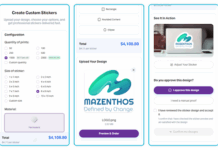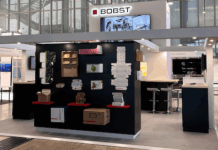Focus Label Machinery looks at the main smart labels technologies and how users can respond to new market demands through their print services. What are smart labels, how have these new technologies impacted the way that businesses produce labels, and how easy is it to implement smart labels?
The Rise Of QR Codes In Smart Labels
QR codes have become a ubiquitous part of the modern consumer landscape, found everywhere from bus stops to soft drink labels. QR codes – or Quick Response codes – are square-shaped patterned barcodes that can store a greater wealth of information than a traditional linear barcode. This includes URL links, product details, inventory management information, and even promotional content.
QR codes are used in labels as a supply chain management tool and to improve the way that consumers are able to interact with product information. For example:
Improved product traceability: QR codes create greater supply chain transparency by giving stakeholders access to a product’s provenance, manufacturing process, production date, origin, and authenticity, streamlining processes and reducing risk.
Interactive marketing: businesses are using QR codes to create enriched and immersive promotional and marketing experiences for their customers, from embedding discount codes to links to personalised landing pages, and even nutritional information.
Data collection: QR code scans give businesses invaluable insights into customer behaviour, including purchase location, device usage, and peak times for purchases. Many dynamic QR codes can even be updated with new content after the product is in the consumer’s hands, keeping their marketing material fresh.
Easy to add: The great thing about QR codes is they can be printed easily without any special equipment. QR codes are easy to generate at pre-press through dedicated websites and apps.
Variable Data Printing And Personalisation – The Digital Print Solution
If QR codes represent the market need, then variable data printing (VDP) is the response by the sector. VDP is a digital printing technology that allows businesses to customise different elements on each printed label, without needing to produce a new flexographic plate or slowing down the printing process. With a lot of the growth factors in label printing being tied to the need of retailers for unique and tailored labelling, VDP has a variety of interesting applications for print businesses.
In order to produce VDP on-the-fly, then some form of digital print integration is going to be required on an analogue printing press. For example, for many industries, including healthcare and food, businesses have to comply with strict labelling laws, which may vary from jurisdiction to jurisdiction. VDP allows printers to produce the unique codes, expiry dates, and compliance information that customers need to meet these regulations on different batches of a print run, without having to duplicate set up and design costs.
One could, for example, produce different consumer labels for the UK, the USA, and the EU, with different relevant information, within the same print run, feeding variable data into placeholders on a digital label template. This ‘personalisation at scale’ is what allows label printing businesses to adapt quickly to market demands, shifts in regulation, and seasonal trends, positioning them for long-term growth and success.
FOCUS LABEL MACHINERY
https://www.focuslabel.com





















